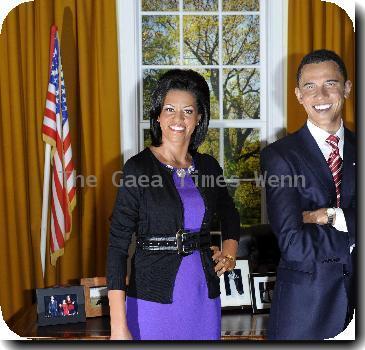Toxic gas levels in W.Va. mine drop; rescuers hope to get inside soon to look for survivors
By Vicki Smith, APThursday, April 8, 2010
Conditions improving for W.Va. mine rescue effort
MONTCOAL, W.Va. — Searchers who came within 500 feet of a rescue chamber where possible survivors of a deadly mine explosion may have taken refuge hoped for another chance Thursday night if levels of noxious gas continue to drop.
Teams spent more than four hours in the morning working their way by rail car and on foot through the Upper Big Branch mine where 25 workers were killed on Monday in the worst U.S. mining disaster in more than two decades. When told to abandon their mission because of the explosive mix of gases had become too dangerous, team members were angry, but their safety was paramount, said Chris Adkins, chief operating officer for mine owner Massey Energy Co.
Crews at the surface resumed drilling to get fresh air into the mine. Gov. Joe Manchin said Thursday evening that the levels were near those considered safe.
“We’re just moving as quickly as we can,” Manchin said. “We want to bring the loved ones back.”
Rescue teams were headed first to the airtight chamber that has at least four days worth of food, water and oxygen.
Massey’s chief executive officer, Don Blankenship, continued to defend his company’s record and disputed accusations from miners that he puts coal profits ahead of safety.
“To some extent the fact that there were more survivors than those that are lost suggests that the mine was in pretty good shape relative to what mines would have been in the past and hopefully by today’s standards,” he told The Associated Press in an interview Thursday. There were 61 miners in Upper Big Branch when it was rocked by the blast.
Despite the increasingly slim chance of finding anyone alive, Adkins said he considered Thursday’s effort a rescue mission.
“I still believe in God, I believe, and I’m not gonna give up,” he said.
The rescue crews did not get far enough to see the bodies of the dead or if anyone had made it to the chamber. They knew where the bodies would be because rescuers made it that far before gases forced them out of the mine after the explosion Monday.
Officials were not sure what caused the high gas levels this time but said a drop in barometric pressure as a storm rolled in might be to blame.
Regina Lilly was at Arvon’s Floral in Whitesville buying a black and yellow ribbon arrangement to hang on her front door in support of the miners. She has friends in the mines who are like family.
“They want answers; they’re not getting answers,” she said of the families of those missing or dead still inside. “They want their family members brought out of that mine; they haven’t got that yet.”
It was made worse by having hopes the crews could get there to learning they had to turn back.
“It’s went from shock to, it’s like an emotional roller coaster,” she said.
Manchin said the families of those stll in the mine were being patient.
“These are the strongest, toughest people I’ve ever seen,” he said. “These people can handle about anything you put up.”
Rescuers had already had to wait to enter the mine until crews drilled holes deep into the earth to ventilate lethal carbon monoxide and highly explosive hydrogen as well as methane gas, which has been blamed for the explosion. The air quality was deemed safe enough early in the day for four teams of eight members each to go in.
Adkins said rescue teams described seeing evidence of “a horrendous explosion and a lot of destruction.”
He also said they may have found an alternate route that will allow them to get where they need to be faster when they can safely go back in.
Once that happens, rescuers will have to walk through an area officials have described as strewn with bodies, twisted railroad track, shattered concrete block walls and vast amounts of dust. Each team member wears 30 pounds of breathing equipment, lugs first-aid equipment and must try to see through total darkness with only a cap lamp to light the way.
Two miners were injured in the blast but managed to get out. One was in intensive care. Cathy Boyd, a nursing supervisor at Raleigh General Hospital, said Thursday that the miner had been released but his family has asked for privacy.
Seven bodies were pulled out Monday and at least 18 remained in the mine.
The federal mine agency has appointed a team of investigators, and President Barack Obama said Thursday that he has asked federal mine safety officials to report next week on what may have caused the blast.
The mine is outfitted with air-quality sensors that shut down some of the mining machinery when methane levels reach a high level.
Manchin said it’s unclear whether the methane levels reached that point prior to the blast, or whether the sensors detected it. However, the positioning of several bodies in an underground rail car begs the question: “Did a sensor not go off?” the governor said Thursday.
“The miners that they found, it doesn’t look like anyone was alarmed or warned that something as this horrific was going to happen,” Manchin told The Associated Press.
Even with high gas levels inside the mine, there must have been a source of ignition, Manchin said, and it’s unclear what that might have been.
Massey has been repeatedly cited for problems with the system that vents methane and for allowing combustible dust to build up, including two large fines assessed in January when federal inspectors found dirty air flowing into an escapeway where fresh air should be, and an emergency air system flowing in the wrong direction. Miners were so concerned about the conditions that several told their congressman they were afraid to go back into the mine.
Even the day of the blast, the federal mine agency cited the mine for two safety violations, one involving inadequate maps of escape routes, the other concerning an improper splice of electrical cable. Kevin Stricklin of the federal Mine Health and Safety Administration said, however, that those violations had nothing to do with the explosion.
Blankenship, the Massey CEO, has strongly defended the company’s record and disputed accusations from miners that he puts coal profits ahead of safety.
He told AP in an interview Thursday that the company would pay funeral expenses for the miners killed in the blast. He also said he does not think the company has any information about methane levels in the mine before the explosion.
The Upper Big Branch mine produced more than 1.2 million tons of coal last year and uses the lowest-cost underground mining method, making it more profitable. It produces metallurgical coal that is used to make steel and sells for up to $200 a ton — more than double the price for the type of coal used by power plants.
__
Associated Press Writers Allen G. Breed, Greg Bluestein, Tom Breen, Dena Potter, Tim Huber and John Raby and videojournalist Mark Carlson in West Virginia; Mitch Weiss and Mike Baker in North Carolina; Ray Henry in Atlanta; and Sam Hananel in Washington contributed to this report.
(This version CORRECTS RESTORES AND corrects 12th graf to say Regina Lilly, sted of Carolyn Kaster. Next briefing scheduled for around 10:30 p.m. EDT. Moving on general news and financial services. AP Video.)
Tags: Accidents, Air Quality, Barack Obama, Energy, Explosions, Montcoal, North America, Personnel, Search And Rescue Efforts, United States, West Virginia






